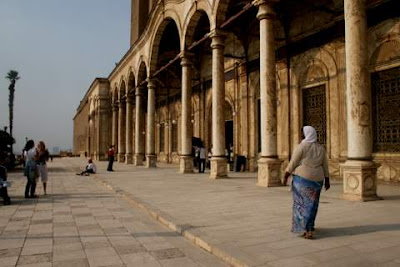The Hanging Church derives its name from its position over the southern tower gate of the old Babylon Fortress, with its name suspended over the passage, and is arguably the most famous Coptic Christian Church in Cairo. It was probably built between 600 and 700AD and has a fascinating history, more of which can be read here.
Below are a few images from our walk through town in order to find the Monastery and Church of St. George. Coptic Cairo is peaceful and stands in contrast to the surrounding districts largely due to the lack of traffic and bustle. Most of the locals we see are sat alone or in pairs in cafes by the roadside, and if they are working, it is behind the counter of a postcard shop. Even the security men at the metal detectors seem half-asleep and chuckle as we pass.
Below are a few images from our walk through town in order to find the Monastery and Church of St. George. Coptic Cairo is peaceful and stands in contrast to the surrounding districts largely due to the lack of traffic and bustle. Most of the locals we see are sat alone or in pairs in cafes by the roadside, and if they are working, it is behind the counter of a postcard shop. Even the security men at the metal detectors seem half-asleep and chuckle as we pass.
The Greek Orthodox Church of St George here has been burned down many times; the current structure was built in 1909 and still has some of the beautiful old stained glass windows, and houses a variety of works of art depicting the story of St. George. It is one of the very few round churches in the East and stands next to a Greek Orthodox cemetery. There are no tourists here despite the church's fame, and the graveyard stands empty except for a security guard who, on seeing our dismayed faces at what appears to be a break-in, explains that many of the ornate burial places are so old they are beginning to fall in. The place is silent, and a cool breeze blows through; it's easy to forget we are in Cairo at all.
Below, a few from our walk back out to the main road, through a partially hidden alleyway lined with shops selling old books and even older black-and-white photographs (the bellydance top Tasha is trying on would not fit and a policeman came over to help!). We also briefly enter a synagogue, the first I have ever been in, which stands shoulder-to-shoulder with the Christian structures and is again hugely impressive.
The citadel is located on the top of Muqattam hill near the centre of Cairo in an area famed for its enormous, grand mosques overlooking the highway. Unfortunately we have no time on the way to stop and take photos of this part of town, let alone the huge and sprawling City of the Dead nestled in a walled area close by (our only male companion refuses to go and 'look at poor people') - but I will certainly be going back to have a proper look at both.
We arrive at the Saladin Citadel of Cairo in the last of the dying sun and walk up the hill to come face-to-face with the spectacular mosque, almost 900 years old and still in use today. The citadel was first fortified by Saladin to protect it from the Crusaders and has since undergone numerous additions and renovations, and today is also the site of a Writers' Union, National Military Museum and Police Musem.
We arrive at the Saladin Citadel of Cairo in the last of the dying sun and walk up the hill to come face-to-face with the spectacular mosque, almost 900 years old and still in use today. The citadel was first fortified by Saladin to protect it from the Crusaders and has since undergone numerous additions and renovations, and today is also the site of a Writers' Union, National Military Museum and Police Musem.
Today, tourists dressed in apropriate garb are also allowed inside the mosque, and despite the hushed talk and the groups of awestruck non-Muslims the overwhelming feeling is one of absolute peace and majesty. The afternoon prayer begins as we sit inside under the beautiful domed ceiling and the faithful move to the front to listen to the imam; as with a mosque I visited in Jordan earlier this year, several Cairo inhabitants are dozing against the wall, entirely content and safe in the presence of God. Not for long though; the citadel is closing for the evening, and so we unwillingly begin the walk back to the entrance.
Tomorrow: el Alamein memorial service, back in Alexandria. I would like to point out that a day immersed in the history of Cairo, or at least in the physical remains that inspired us all to actually sit down and learn when we arrived home, cost each of us less than £10 English - once again testament to the age-old Arab understanding that money cannot and will never account for everything. For an ordinarily militant atheist such as myself to admit to feeling not merely impressed but humbled is a huge step, and I urge any future visitors to use their time in the city to its fullest, as we left with the feeling, as always, that there was so still much more to discover.























No comments:
Post a Comment